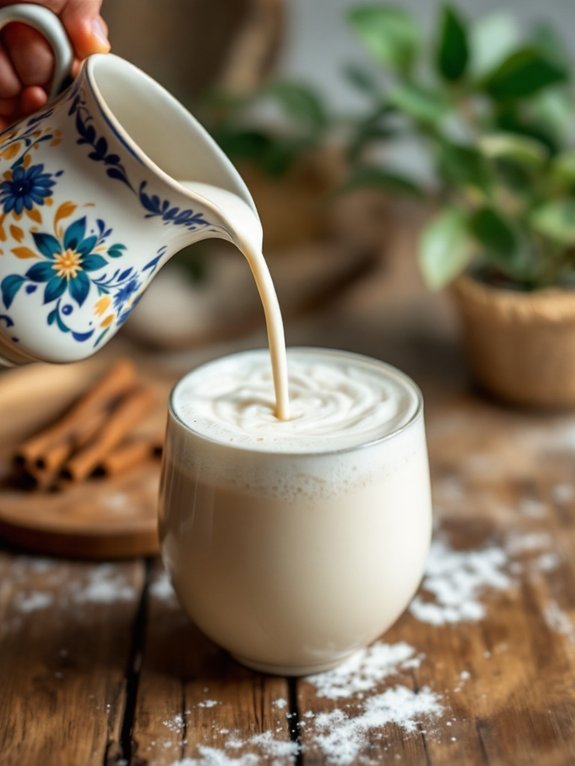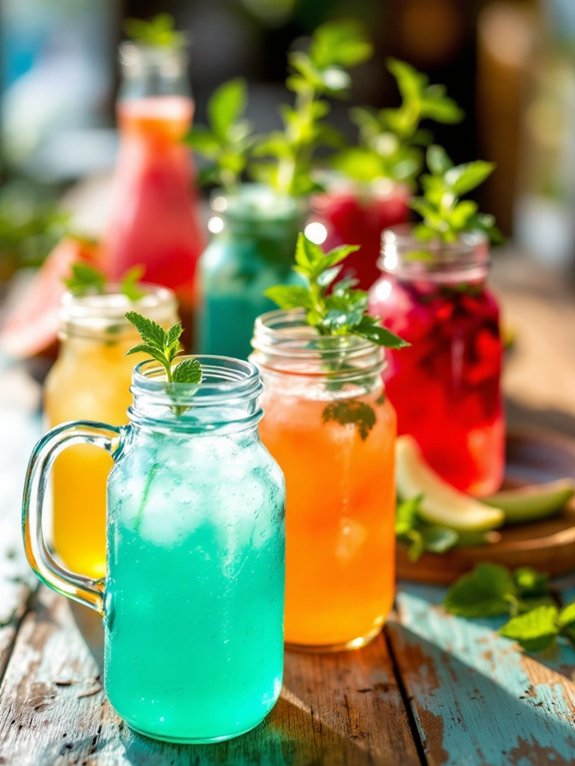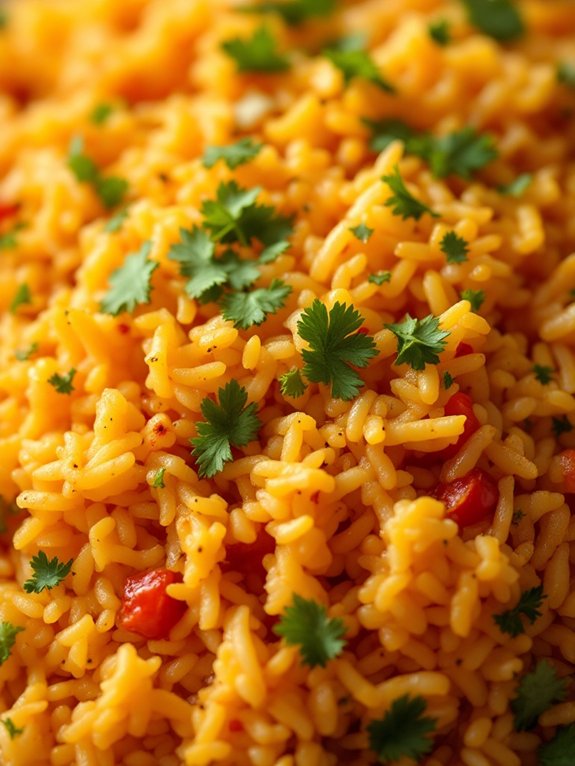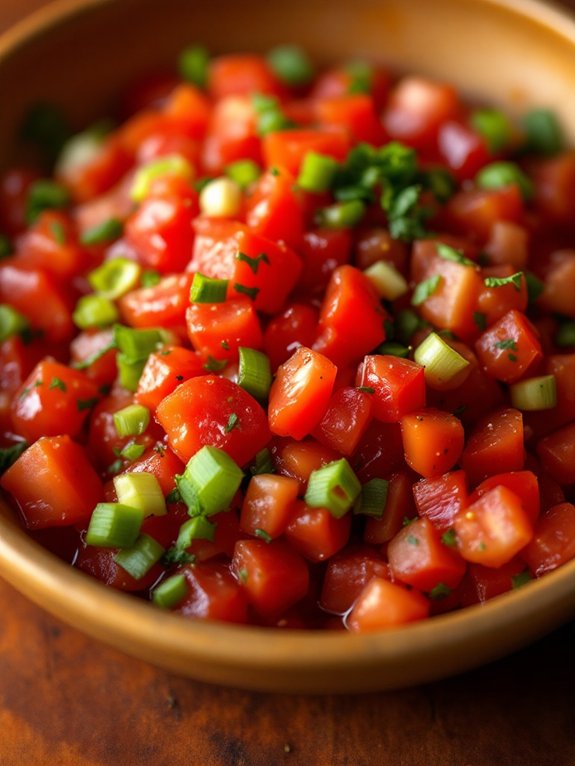You're about to fall head over heels for creamy Mexican horchata, a ridiculously delicious drink that's like a warm hug in a glass. This sweet, milky creation has been around for centuries, originating from ancient Egypt and developing in Spain before becoming a staple in Mexican culture. You'll be blending rice, cinnamon, and evaporated milk to create a velvety texture that's simply irresistible. And trust us, once you get the hang of making it, you'll be serving it up at every gathering and party. But what makes this drink truly special? Well, that's just the beginning…
Quick Facts
- Creamy Mexican Horchata is a traditional drink made with rice, cinnamon, and milk, symbolizing unity and cultural heritage.
- The recipe includes soaking rice and cinnamon in water, blending with additional water, and mixing with evaporated milk for creaminess.
- Optional ingredients like sweetened condensed milk, heavy cream, and vanilla extract can enhance the flavor and texture.
- To achieve a smooth texture, the mixture should be strained through cheesecloth or a fine mesh sieve before refrigeration.
- Horchata can be served over ice, garnished with cinnamon, and paired with savory dishes to balance its sweetness.
History
The murky waters of horchata's past – let's plunge right in. You're probably thinking, "Mexico, right?" Well, not exactly. Horchata's ancient origins date back to Ancient Egypt, where a barley-based drink was all the rage. It then spread to North Africa, where it got a makeover with tiger nuts and became "horchata de chufa." Fast forward to the 8th century, and the Moors brought it to Spain, where it evolved into the tiger nut-based drink you'll find in Valencia today.
But what about Mexico? Ah, patience, amigo! The Spanish conquistadors introduced horchata to Mexico in the 16th century, but with a twist – they used local ingredients like rice. And just like that, horchata de arroz was born. This creamy drink became an integral part of Mexican cuisine, and its cultural significance can't be overstated. It's more than just a drink; it's a symbol of tradition, community, and freedom. Valencia's climate also played a significant role in popularizing tiger nut-based horchata. So, the next time you sip on a glass of horchata, remember its rich history and the cultures that shaped it. Pretty cool, huh? Now, let's raise a glass to this delicious, freedom-filled drink!
Recipe
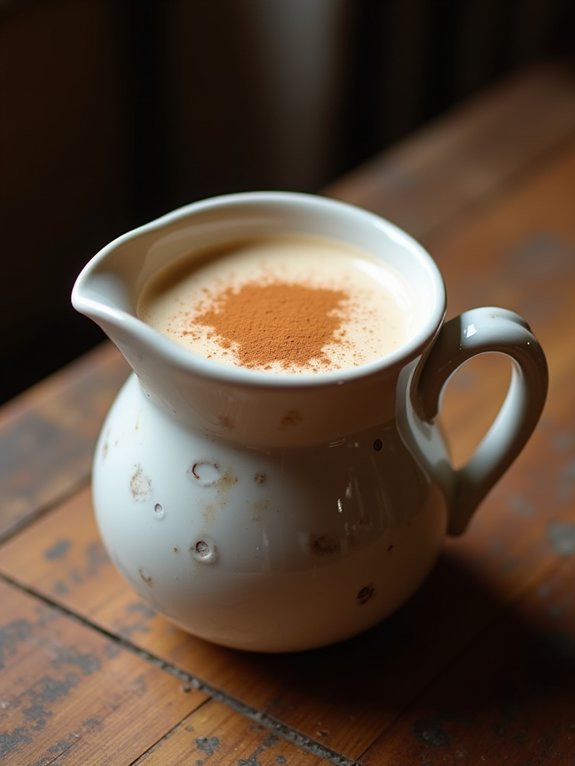
A traditional Mexican beverage made with rice, cinnamon, and milk, horchata holds a beloved place in many cultures. With a rich, milky texture and touches of sweet and spicy flavors, it's perfect for sipping on a warm day or serving alongside your favorite dishes.
Because homemade horchata requires some preparation and soaking time, allow for several hours or overnight before enjoying. Make use of a high-speed blender to thoroughly grind and mix ingredients and be patient with the soaking and chilling steps.
Ingredients:
- 1 cup uncooked white rice
- 2 cinnamon sticks
- 8 cups water
- 1 can (12 oz) evaporated milk
- 1 can (12-14 oz) sweetened condensed milk
- 1/4 cup heavy cream (optional)
- 2-4 tablespoons granulated sugar (optional)
- ½ teaspoon vanilla extract
Combine the rice and cinnamon sticks with 4 cups of water in a bowl and let soak for at least 4 hours or overnight. Drain and blend the mixture in a high-speed blender, adding 2 cups of water as needed to grind the ingredients smoothly. Transfer the mixture back to the bowl and mix in the evaporated milk, sweetened condensed milk, and optional heavy cream.
Add sugar to taste, as the condensed milk already sugary, then add vanilla extract to give a delicate twist to the horchata. Refrigerate after straining the mixture through cheesecloth or a fine mesh sieve. Chill several hours or overnight for the best flavor and serve over ice with a sprinkle of ground cinnamon for garnish. The horchata may have separated while in the refrigerator; a gentle stir will return the drink to a uniform consistency.
When making horchata, be prepared for the soaking process to release starches from the rice that can settle at the bottom and leave a fine grittiness in the liquid. A good blender and careful straining can minimize the texture. Keep your homemade horchata refrigerated and use within a few days for the best taste and freshness. This recipe yields approximately 10 to 12 servings with ice.
Final Thoughts
As you're now a certified horchata aficionado, having made it through the recipe and examined the drink's rich cultural significance, historical roots, and regional variations, you're probably thinking, "What's the big deal about horchata, anyway?" Well, let me tell you – this creamy, sweet, and spicy drink is more than just a tasty beverage; it's a cultural icon, a symbol of community and tradition that's been bringing people together for thousands of years.
You've got the basics down, but let's talk about what really matters: horchata's cultural importance. It's not just a drink; it's a staple at Mexican and Latin American gatherings, providing a sweet counterbalance to savory dishes. The traditional tiger nuts used in horchata originated from the Valencia region of Spain, where this blend is still popular using the local tiger nuts. With its rich history and regional variations, horchata is a symbol of community and tradition. Whether you're sipping on a traditional Mexican horchata or trying a modern variation with fruits or nuts, you're participating in a cultural phenomenon that transcends borders and time. So go ahead, grab a glass, and join the horchata fan club – your taste buds and sense of cultural connection will thank you. Horchata variations may differ, but its cultural importance remains the same: bringing people together, one delicious sip at a time.
Frequently Asked Questions
Is Horchata a Popular Drink in All Regions of Mexico?
Oh, you think horchata is a universally adored drink in Mexico? Think again, amigo! While it's widely popular, regional variations abound, and its cultural significance is more pronounced in certain areas, but not all.
What Types of Milk Can Be Used for Horchata Besides Cow Milk?
You're ditching cow's milk – awesome. You can use rice milk for a creamy vibe or go nuts with almond, oat, or cashew milk; tiger nut milk's also a revolutionary option, along with other nut milk alternatives.
Can Horchata Be Enjoyed During Any Time of the Year?
You can indulge in horchata whenever you please, because who needs seasonal variations, anyway? It's perfect for festive occasions, but let's be real, you don't need a party to enjoy this creamy drink – go ahead, rebel!
Is There a Difference Between Mexican and Spanish Horchata?
You're wondering if there's a difference between Mexican and Spanish horchata – well, duh, ingredient variations give it away, but let's get real, their cultural significance is what really sets these two tasty treats apart.
Does Traditional Horchata Contain Caffeine or Other Stimulants?
You're seeking a stimulating answer, but traditional horchata's got none – no caffeine sources sneak into traditional recipes, leaving you free to indulge without any buzz, because who needs an energy lift, right?
